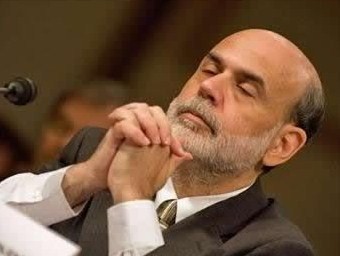 Invest Intelligence When It Realy Matters
Invest Intelligence When It Realy Matters
America's Second Great Depression 2010 Year-End Update (Part 1)
“Regarding the Great Depression. You’re right, we did it. We’re very sorry. But thanks to you, we won’t do it again.” [1]
That quote was taken from a speech made by then Board of Governors member Ben Bernanke in 2002 to the Federal Reserve. Unfortunately, Bernanke’s pledge has been broken.

As clueless as Bernanke has been, if you follow what he says closely, on occasion you will see his own admission that the U.S. is either in a depression or is certainly headed for one.
For instance, on Tuesday November 30, 2010, as Bernanke attempted to defend his recent decision to buy $600 billion of U.S. Treasuries, he made ridiculous claims that this quantitative easing would lead to more jobs. He then used the often used scare tactic to justify this move by saying that a long period of high unemployment could exact a steep social cost.
"There are obviously very severe economic and social consequences from this level of unemployment," so getting new jobs, getting unemployment down is of an incredible importance."
“The unemployment rate is still going to be high for a while, and that means that a lot of people are going to be under financial stress.”
Recently, Bernanke predicted unemployment will remain high for "four or five years." [2]
So what is Bernanke trying to say? Read between the lines for yourself. First, he has said that there will be very severe social and economic consequences from this high level of unemployment. What does “Very severe social and economic consequences” mean? Quite simply, it means a depression.
Then, on December 5, 2010, Bernanke stated that unemployment will remain high for four or five years. By now I’m sure you realize any estimate that sides with optimism by the Fed is a severe understatement. What that means is that high unemployment will last much longer.
But this by no means provides any useful guidance by Bernanke. It should be obvious to any rational adult that we are in a depression. I detailed the causes and effects of this depression in America’s Financial Apocalypse four years ago.
.jpg)
My track record can be found here: /article_details-341.html
So who should you be listening to? Ben Shalom Bernanke? The hacks in the media? You can decide for yourself.
Now if you’ve decided to listen to me, I’m going to tell you why the unemployment rate is so high and will remain high for many years to come. But you’ll have to wait for Part 2 of this article.
First, let’s summarize what has happened. Over the past two years we have seen some of the worlds strongest, oldest, most successful financial institutions file for bankruptcy or participate in forced buy outs to avoid further crisis.
First, in early March 2008 Bear Stearns collapsed due to lack of confidence from investors. By the summer, Indy Mac had failed and Fannie Mae and Freddie Mac were insolvent. [3] [4]
Throughout 2007 and 2008, many investors were told by the hacks on TV that the financials represented a “great value.” As a result, the sheep piled in. Thereafter, they watched shares collapse. [5]
.jpg)
By the first week of August 2008, everyone else was fixated on Fannie and Freddie. But I already knew their fate, as I had previously instructed investors to short Fannie and Freddie and many other mortgage and bank stocks in my 2007 book, Cashing in on the Real Estate Bubble.
I was already looking ahead. I warned readers we would see an earnings meltdown. I advised investors to sell, and aggressive investors to short the market.
"Standard & Poor’s earnings estimates for Q2, Q3, and Q4 of 2008 are -11%, 40%, and 60% respectively. Remember, this the same S&P that rated the mortgage junk AAA. It will also be the same S&P that will end up issuing drastic revisions in earnings once the bottom falls out. But that won’t help investors after the fact."
"Sure, it’s possible that we will see the market rally over the next couple of months. If so, you would be wise to sell. More aggressive traders might consider shorting it entirely once it tops out based on the 1-year resistance trend line."
Source: /article_details-84.html
During the first week of September, Fannie and Freddie were placed into government conservatorship to prevent each from failing. Eight days later, Lehman Brothers filed for bankruptcy protection. [6] [7]
On the same day, Bank of America announced it would purchase Merrill Lynch at a huge premium. Immediately after the deal was announced I discussed that this was one of many bailouts disguised as a buyout arranged by the Federal Reserve and the Treasury Department. [8]
The following day, AIG received a government bailout to the tune of $85 billion. This would be the first of more installments to come. Of course, the only reason AIG was bailed out was because Goldman Sachs stood to lose $20 to $30 billion. [9]
Understand that Bernanke was directly responsible for these deals, and each one was littered with fraud.
Less than two weeks later, Washington Mutual was suddenly seized despite having received a clean bill of health through at least the rest of the year by the Office of Thrift Supervision.